This week, Congress enacted six of the twelve annual discretionary appropriations bills for FY 2024 (which is already 5 months underway). Combined, this 6-bill “minibus” provides roughly one-quarter of total discretionary appropriations for the current fiscal year. Legislative text for the remaining 6 bills, including appropriations for the Department of Defense and major social programs, has yet to be finalized and must be enacted by April 30 to avoid a sequester of all appropriations (including already enacted bills).
The following tables and charts provide a summary of what Congress accomplished with this first minibus and what remains.
This First Minibus Focuses Largely on Non-Controversial Agencies and Programs
There are 15 executive departments and over 400 agencies and sub-agencies of the federal government. Legislation passed by Congress this week (H.R.4366, The Consolidated Appropriations Act, 2024) provides funding for the least controversial:
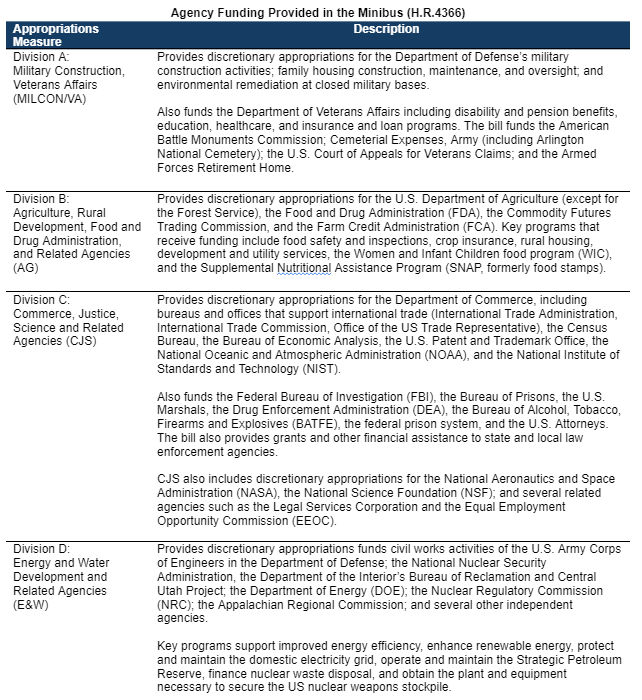
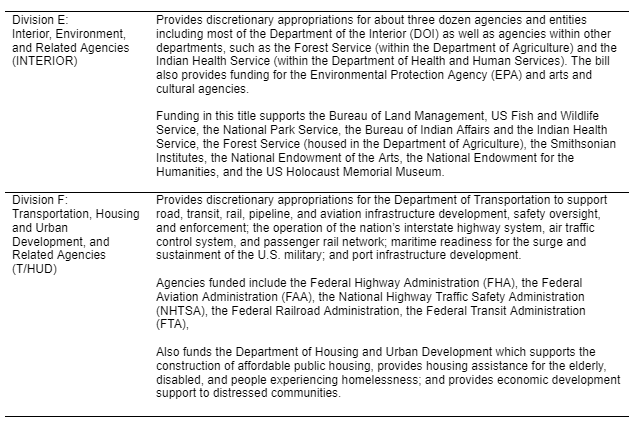
The First 6-Bill Minibus Appropriates Roughly One-Quarter of All Discretionary Spending for FY 2024
According to the cost estimate prepared by the nonpartisan Congressional Budget Office (CBO), the minibus would appropriate a grand total of $513.7 billion in discretionary budget authority for FY 2024. However, this amount includes $68.2 billion in emergency-designated spending provided by legislation enacted prior to last year’s Fiscal Responsibility Act (FRA)—funding that will not count towards enforcement of the FY 2024 spending caps. For purposes of the caps, HR 4366 appropriates $445.6 billion in budget authority, roughly one-quarter of total discretionary spending subject to the FY 2024 caps (assuming all appropriations are completed on time and a sequester is avoided). Phrased differently, funding for nearly three-quarters of discretionary spending has yet to be determined:
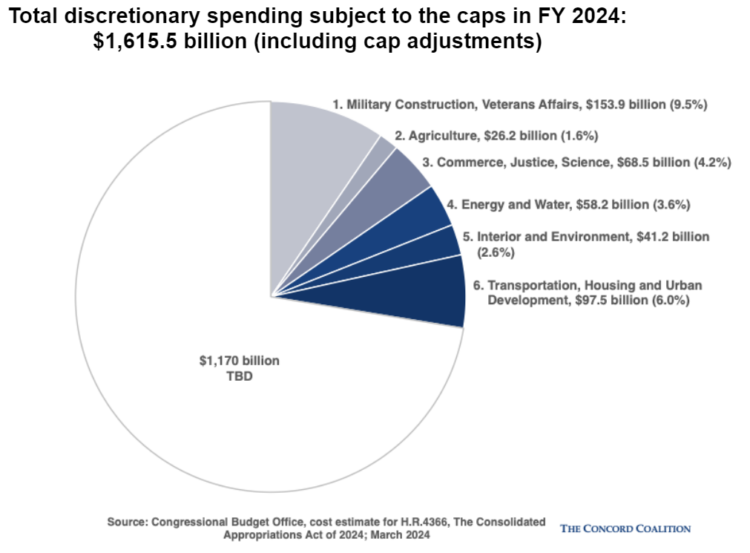
Comparisons to FY 2023 Levels are Obscured by One-Offs and Budget Gimmicks
The table below compares discretionary spending levels in the 6-bill minibus with FY 2023 using publicly available data, but a true apples-to-apples comparison is complicated by one-off changes, side deals, and budget gimmicks that skew the data (see notes). In the final accounting, total FY 2024 discretionary spending should be about 2 percent higher than FY 2023.
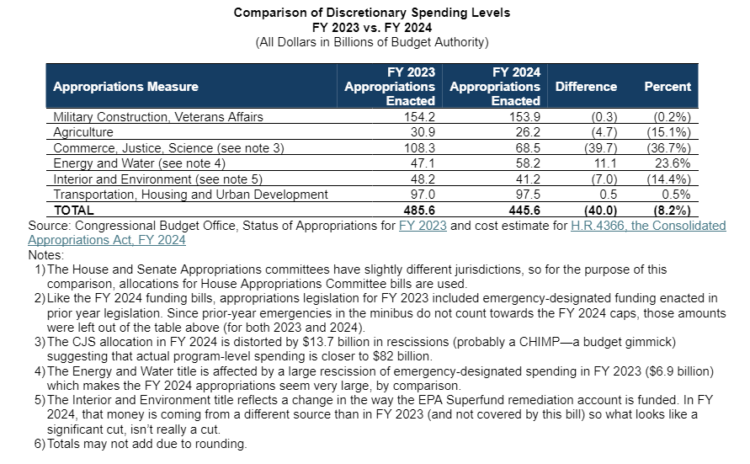
How Does this Minibus Stack Up Against the Spending Caps for FY 2024?
The FRA established two spending caps for FY 2024—one for defense-related discretionary spending and one for non-defense. While some agencies receive funding from just one bucket (e.g., the Agriculture and Related Agencies bill does not contain any defense-related spending), some receive funding from both buckets (e.g., the Energy and Water title includes both defense-related and nondefense appropriations for the Department of Energy). The following figure illustrates current progress in relation to the FY 2024 caps based on funds appropriated in the minibus:
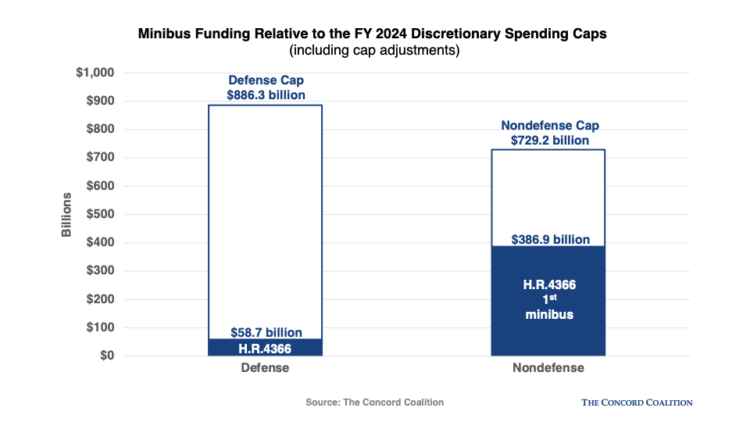
Note: An alternative set of reduced caps (enforced via sequester) would be triggered if Congress does not complete the entire FY 2024 appropriations process by April 30.
Is There Anything Else in the Minibus?
Policy riders. Although there are Senate rules against “legislating” in an appropriation bill (i.e., setting new policy in an appropriations bill), if the House does it first, the Senate prohibitions get harder to enforce. Unfortunately, as the culture wars in domestic politics have escalated, so too has the prevalence of policy riders in appropriations legislation. Moreover, it’s often the riders that hamstring the budget process, not the actual spending levels.
In February, conservative Republicans delivered a list of demands to Speaker Mike Johnson for him to secure as part of the FY 2024 appropriations negotiations. None of them made it into this minibus but Republicans did secure the following policy riders:
- A provision that prevents the sales of oil in the Strategic Petroleum Reserve to China (Division D, Title III, sec. 309).
- A provision that prohibits the Justice Department from targeting or investigating parents who “peacefully protest at school board meetings and are not suspected of engaging in unlawful activity.” (Division C, Title II, sec. 220).
- A provision that would allow veterans determined unable to manage their benefits to be able to purchase guns (Division A Title IV, Sec. 413).
Earmarks. The FY 2024 minibus contains over 6,600 congressionally directed spending projects (“earmarks”) totaling approximately $12.6 billion. Over half are in the Transportation title alone (worth $6 billion). The earmarks are disclosed in tables in the explanatory reports that go along with each section of the bill. For example, Transportation appropriation earmarks are here.
Health extenders. Division G of H.R.4366 includes a variety of non-controversial health-related program extensions that affect Medicare, Medicaid, and public health spending. These provisions are categorized as direct (mandatory) spending, and their costs are not applied against the discretionary caps. To offset the cost of these spending items, Division G extends for an additional two months (through November 2032) the sequester of Medicare payments to providers (physicians, hospitals) originally enacted as part of the Budget Control Act of 2011.
No supplemental appropriations; no tax bill. Two stalled legislative vehicles failed to hitch a ride on this first minibus: (1) the international security supplemental with emergency funding for Ukraine, Israel, Gaza, Taiwan, and the U.S. southern border; and (2) the House-passed bipartisan tax bill. The outlook for both is uncertain.
What Happens Next?
Under the current stopgap funding patch or “continuing resolution” (CR), Congress has until March 22 to complete the remaining six appropriation bills, including the massive defense appropriations bill. If lawmakers can’t meet this deadline, another short-term extension will be necessary to avoid a funding lapse at the affected agencies and departments. Media reports suggest Congress is on track to meet this deadline and could release text of the second bill next week, but negotiations over policy riders and funding constraints may slow progress (in Washington, nothing is agreed to until everything is agreed to).
The ultimate deadline, of course, is April 30 when even a one-bill CR past this date would trigger a sequester across all 12 appropriations measures (even those with full-year enacted appropriations).
Stay tuned.




